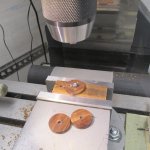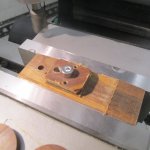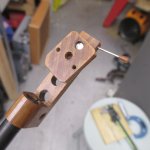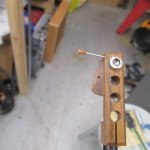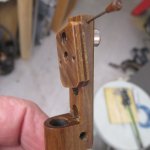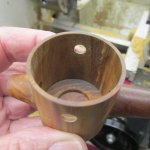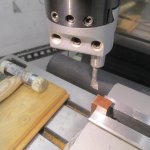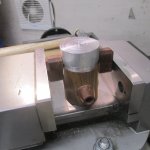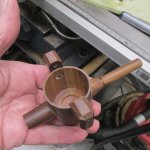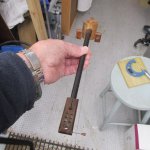Hi my wife and I have just spent the last hour or so discussing Mr Mark Tillotson's comment about my use of exotic hard woods, Lignum Vitae in particular.
And yes we have all squandered our planets natural resources for too long, and now and even more for our children it is unavoidabley PAY BACK TIME and even then if it is not already too late.
90% of the hard woods that I use are upcycled from damaged and discarded antiques and in the case of lignum Vitae mainly old bowling balls, the very fact that these materials are old with many years of use mean that all the stresses have long dissapated them selves which make these materials so suitable for my use.
On the few occasions that I have had to resort to buying hardwoods from timber suppliers, I have used certified suppliers of at least fourty year old stock.
Before I retired from nearly fifty years as a tool maker in aerospace I gained a deep knowlege of working many kinds of exotic and less exotic materials such as delrin and yes in some cases it would make a suitable substitute for lignum vitae, BUT unlike lignum vitae it will not decay it will hang about in our environment for many many years as micro plastic slowly poisoning generations to come.
I believe that high end audio raises engineering to an art form.
If you want plastic audio equipment go and buy an Amstrad and throw it in land fill after a couple of years.
And yes we have all squandered our planets natural resources for too long, and now and even more for our children it is unavoidabley PAY BACK TIME and even then if it is not already too late.
90% of the hard woods that I use are upcycled from damaged and discarded antiques and in the case of lignum Vitae mainly old bowling balls, the very fact that these materials are old with many years of use mean that all the stresses have long dissapated them selves which make these materials so suitable for my use.
On the few occasions that I have had to resort to buying hardwoods from timber suppliers, I have used certified suppliers of at least fourty year old stock.
Before I retired from nearly fifty years as a tool maker in aerospace I gained a deep knowlege of working many kinds of exotic and less exotic materials such as delrin and yes in some cases it would make a suitable substitute for lignum vitae, BUT unlike lignum vitae it will not decay it will hang about in our environment for many many years as micro plastic slowly poisoning generations to come.
I believe that high end audio raises engineering to an art form.
If you want plastic audio equipment go and buy an Amstrad and throw it in land fill after a couple of years.
I also enjoy the reusing of usually old products for new purposes, as long as they exactly match the need. Back in the day, a person could even go to the local junkyard and possibly find something for the exact need. 18 years ago, I found new carpet squares which I am using to this day for flooring in my shop so that when a sharp instrument is dropped, the likelihood of damage is much less. Upon getting these squares, I was run out by the employee sitting in an earthmover, mowing the remaining squares into the ground! Yes, they are serious about this stuff now. Sorry for the sidetrack here.
When reading a post, it is important to really grab hold of the actual information given in that post, before considering a rapid response. Don't worry though, I do it as well.
When reading a post, it is important to really grab hold of the actual information given in that post, before considering a rapid response. Don't worry though, I do it as well.
Engineered wood, known by it's commercial name Permali® is a suitable alternative to lignum vitae. It is made from European beech wood that is scientifically farmed . It has cross grain structure and a high density of 1.3gm/cm³ . I have already developed components such as stacking platters , damping ring for Lenco platters , turntable plinths etc.
Permali® was originally a British brand, but since the late nineties ithe ownership transferred to an Indian business who were already manufacturing it since 1960 under agreement with the original British company.
Regards,
Anwesh
Permali® was originally a British brand, but since the late nineties ithe ownership transferred to an Indian business who were already manufacturing it since 1960 under agreement with the original British company.
Regards,
Anwesh
Though I am certain of there are a number of alternatives to Lignum Vitae and other woods, the OP chose wisely for the available product and in its circumstance. Since this thread is about the build itself and not as much about the materials used, let's move on with the development aspect of the product. I am most interested in discussing the bearing used for the tonearm, and its introduction the specific materials used for that.
Hi again I found no shielding issues with the Ebony Warrior, it was a concern but once I had the prototype up and running I found it was not a problem.
I hope that the next arm is the same.
I am a full time carer so it is hard to find as much time in the work shop as I would like. May be a few hours over the weekend.
For now thank you all for your interest.
I hope that the next arm is the same.
I am a full time carer so it is hard to find as much time in the work shop as I would like. May be a few hours over the weekend.
For now thank you all for your interest.
Hi I managed to get back to my spiritual home in the workshop for a couple more hours today which almost got the final part of the headshell's finished.
Luckily I made a spair laminate piece as the first attempt chiped which always a problem when working with small laminated parts in lignum vitae, note how L have designed this part to place the stylus close to the centre line of the armtube.
I did some research to ascertain the average distance between stylus and mounting screws on common cartridges and came to the conclusion that 9mm was about it.
I am expecting my new turntable to arrive from Japan in the morning and hoping that there will not be an extra charge for inport duty. The only turntable that I posses is a vintage Sondek which is not a good candidate for a twelve inch tonearm,
note the stainless cap head screw will eventually be replaced by a hollow titanium version.
Luckily I made a spair laminate piece as the first attempt chiped which always a problem when working with small laminated parts in lignum vitae, note how L have designed this part to place the stylus close to the centre line of the armtube.
I did some research to ascertain the average distance between stylus and mounting screws on common cartridges and came to the conclusion that 9mm was about it.
I am expecting my new turntable to arrive from Japan in the morning and hoping that there will not be an extra charge for inport duty. The only turntable that I posses is a vintage Sondek which is not a good candidate for a twelve inch tonearm,
note the stainless cap head screw will eventually be replaced by a hollow titanium version.
Attachments
Hi back again They say a picture tells a thousand words so to day I am just posting pictures!.
Attachments
-
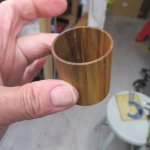 IMG_0563.JPG416.9 KB · Views: 74
IMG_0563.JPG416.9 KB · Views: 74 -
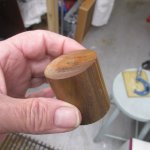 IMG_0564.JPG423.2 KB · Views: 79
IMG_0564.JPG423.2 KB · Views: 79 -
 IMG_0565.JPG491.7 KB · Views: 71
IMG_0565.JPG491.7 KB · Views: 71 -
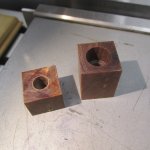 IMG_0566.JPG516.5 KB · Views: 68
IMG_0566.JPG516.5 KB · Views: 68 -
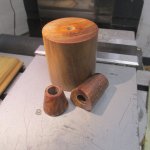 IMG_0568.JPG516.7 KB · Views: 68
IMG_0568.JPG516.7 KB · Views: 68 -
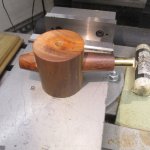 IMG_0569.JPG525.2 KB · Views: 80
IMG_0569.JPG525.2 KB · Views: 80 -
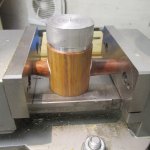 IMG_0570.JPG552.4 KB · Views: 83
IMG_0570.JPG552.4 KB · Views: 83 -
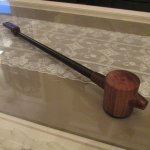 IMG_0571.JPG570.4 KB · Views: 81
IMG_0571.JPG570.4 KB · Views: 81 -
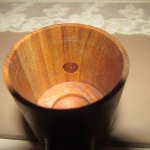 IMG_0572.JPG423.5 KB · Views: 77
IMG_0572.JPG423.5 KB · Views: 77
No bowler would have ever guessed what might have become of his favorite bowling ball. Indeed, the photos are very telling. I just can't imagine how sharp the turning tools must be to get results such as these.
Well I have now got the most complicated part almost fabricated, there is still a great deal to do. I supose about 25% of the work is done but once there is some'thing to look at it becomes much easier to visualise all the other parts that make up the whole thing.
There are no drawings just the odd sketch to work out the spacing so it all fits together.
Here are some more pictures of the work as it progresses.
There are no drawings just the odd sketch to work out the spacing so it all fits together.
Here are some more pictures of the work as it progresses.
Attachments
One question that I have is how are you completely sure about drilling a hole at a 90 degree angle, i.e. perpendicular to the other hole positions? And is it hard to get the right 'lack of angle' on some pieces? It all looks pretty basic from one perspective, but I know differently with this sort of project. A tonearm would be the ultimate challenge for everything to right on....
I guess that a lathe and mill take out some/most of the guesswork, but still, even the wood doesn't want to be drilled straight at times.
I guess that a lathe and mill take out some/most of the guesswork, but still, even the wood doesn't want to be drilled straight at times.
I'm would like to think that your interest using wood for audio purposes has put you in contact with Phenolic Resin Impregnated Densified Wood such as the Brand in the Link.
These are typically selected as a Cross Grain orientation on the plies, but can also be selected as material with same orientation grain on the plies, I am not sure if the Picawood is available as a In line Grain.
Also their is no indication the the preparation for Picawood is creating the wood to be Delignified, where as other Brands are capitalising on how a delignified wood is improved as a material for the process of undergoing high compression and impregnation.
The Link has a Material with a Structure that has the most Plies per 25mm thickness, when compared to other go to Brands for almost identical material.
There are other Brands and other wood enthusiasts have adopted these in place of African Hardwoods and never looked back.
https://mockingbirddistribution.com/pyon-sound/picawood/
P.S I see Anwesh has already suggested one of the alternative Brands.
These are typically selected as a Cross Grain orientation on the plies, but can also be selected as material with same orientation grain on the plies, I am not sure if the Picawood is available as a In line Grain.
Also their is no indication the the preparation for Picawood is creating the wood to be Delignified, where as other Brands are capitalising on how a delignified wood is improved as a material for the process of undergoing high compression and impregnation.
The Link has a Material with a Structure that has the most Plies per 25mm thickness, when compared to other go to Brands for almost identical material.
There are other Brands and other wood enthusiasts have adopted these in place of African Hardwoods and never looked back.
https://mockingbirddistribution.com/pyon-sound/picawood/
P.S I see Anwesh has already suggested one of the alternative Brands.
Last edited:
Hi I have been a little lazy with my postings of late, and now come back to it only to find another thousand views THANK YOU.
1st of all the to answer Laxny, squareness is no problem but I have been doing this sort of thing all my working life and now it all continues into retirement.
And now all this fuss about my use of exotic woods Yes I take your point there are all sorts of engineered wood products that I could be using I have worked with them in industary and yes they are very good and easy to work with but they are after all made from exotic and less exotic hard woods.
1st of all the to answer Laxny, squareness is no problem but I have been doing this sort of thing all my working life and now it all continues into retirement.
And now all this fuss about my use of exotic woods Yes I take your point there are all sorts of engineered wood products that I could be using I have worked with them in industary and yes they are very good and easy to work with but they are after all made from exotic and less exotic hard woods.
Ignore those posts about what material others think that you should be using. Given your experience level, I see no reason to do otherwise. The exotic wood waste topic has been talked to death and doesn't even have anything to do with your project in any way.
This is art science at one of its highest levels.
This is art science at one of its highest levels.
My Posts is not to steer an individual from their options already considered, it is to introduce them to New Options.
Especially ones that are towards materials that are proven as a Material to have intrinsic damping and dissipation properties not commonly encountered in any material, and especially those usually selected for use on a Tonearm.
Especially ones that are towards materials that are proven as a Material to have intrinsic damping and dissipation properties not commonly encountered in any material, and especially those usually selected for use on a Tonearm.
I was looking at the pictures and wondering when the ebony would appear - ah👍
Ebony is a great material for turntable bits, headshells and armboards.
Seems to have the right damping and resonance somehow.
Ebony is a great material for turntable bits, headshells and armboards.
Seems to have the right damping and resonance somehow.
Last edited:
Hi as I said earlier I am building two tonearms to see which suits my new bearing design the best. Type A and Type B the type a arm is finished apart from wireing and polishing see photo, I am now working on type b which I expect will work best.
On type b the bearing is exposed so there will be no finished photos until I have at least a uk patent pending.`
On type b the bearing is exposed so there will be no finished photos until I have at least a uk patent pending.`
Attachments
-
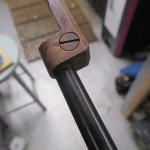 IMG_0591.JPG402.4 KB · Views: 83
IMG_0591.JPG402.4 KB · Views: 83 -
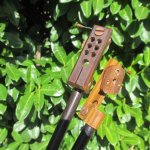 IMG_0593.JPG594 KB · Views: 86
IMG_0593.JPG594 KB · Views: 86 -
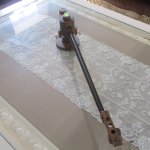 IMG_0597.JPG549.4 KB · Views: 92
IMG_0597.JPG549.4 KB · Views: 92 -
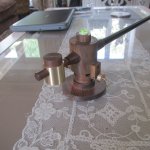 IMG_0598.JPG603.4 KB · Views: 87
IMG_0598.JPG603.4 KB · Views: 87 -
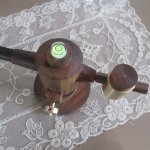 IMG_0599.JPG665.3 KB · Views: 95
IMG_0599.JPG665.3 KB · Views: 95 -
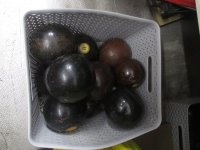 IMG_0603.JPG395.6 KB · Views: 93
IMG_0603.JPG395.6 KB · Views: 93 -
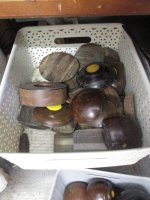 IMG_0607.JPG420.3 KB · Views: 82
IMG_0607.JPG420.3 KB · Views: 82 -
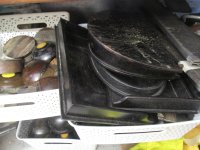 IMG_0608.JPG431.9 KB · Views: 85
IMG_0608.JPG431.9 KB · Views: 85 -
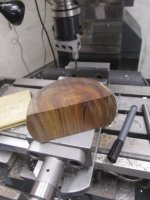 IMG_0609.JPG359 KB · Views: 92
IMG_0609.JPG359 KB · Views: 92
It’s still available in the UK, not sure where it’s made though. Similar product to Panzerholz as I understand it.Engineered wood, known by it's commercial name Permali® is a suitable alternative to lignum vitae. It is made from European beech wood that is scientifically farmed . It has cross grain structure and a high density of 1.3gm/cm³ . I have already developed components such as stacking platters , damping ring for Lenco platters , turntable plinths etc.
Permali® was originally a British brand, but since the late nineties ithe ownership transferred to an Indian business who were already manufacturing it since 1960 under agreement with the original British company.
Regards,
Anwesh
- Home
- Source & Line
- Analogue Source
- The Ebony Warrior. magnetic tonearm made in Huddersfield UK

